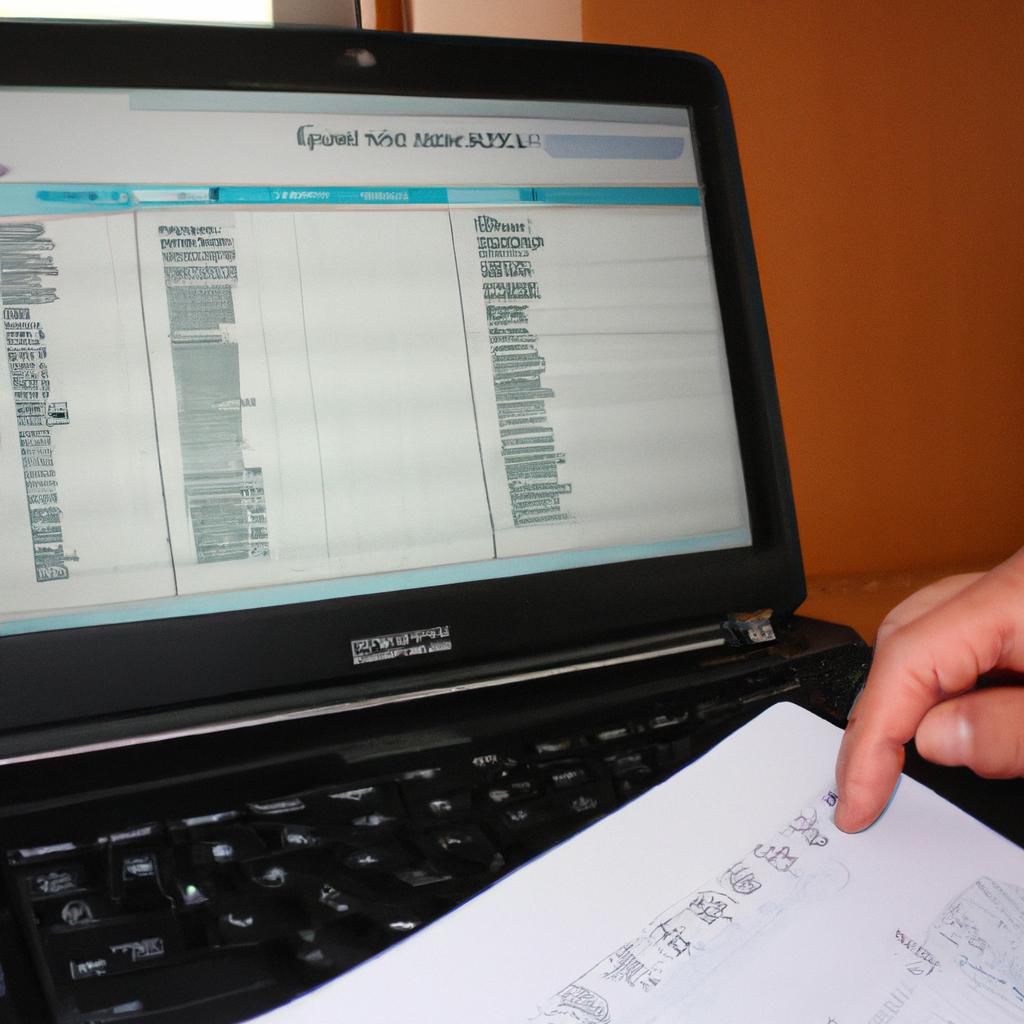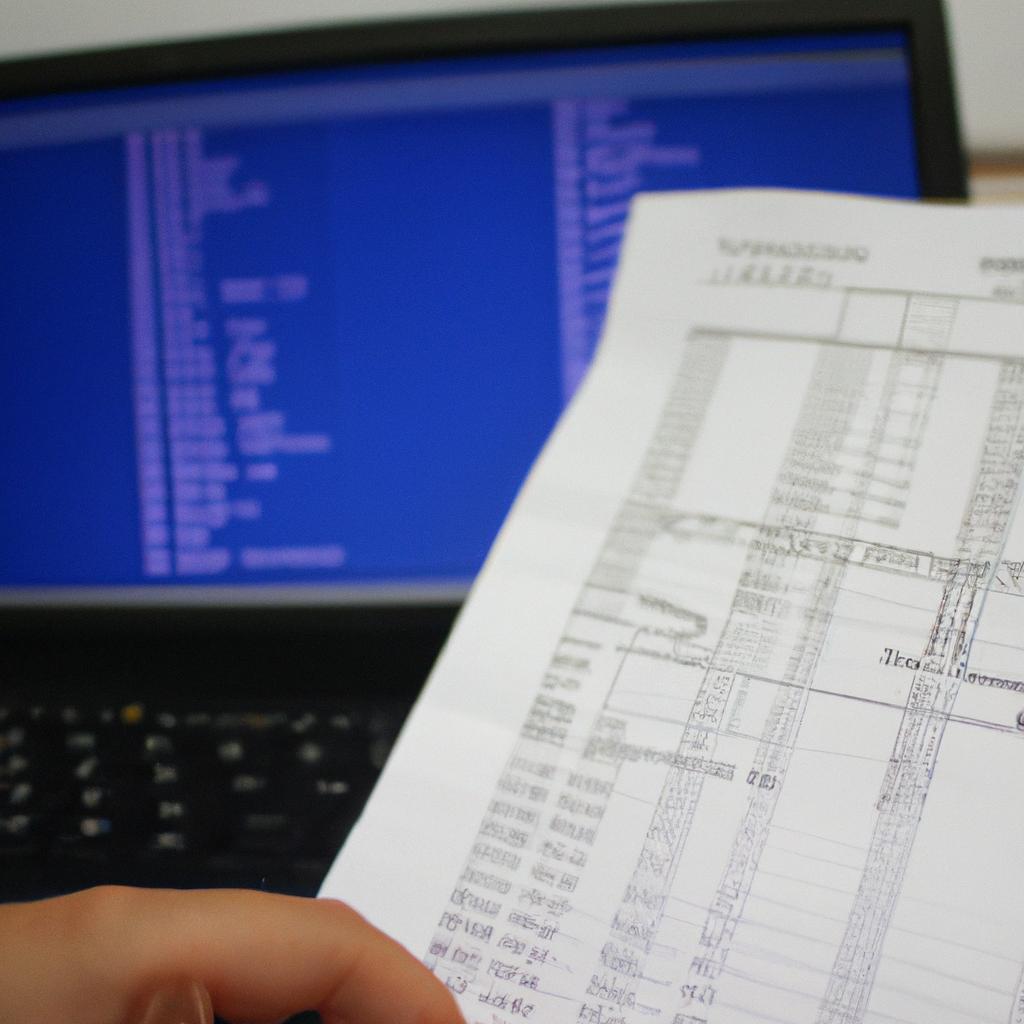Employee Self-Service in Accounting Software: Streamlining Payroll Management

Employee self-service (ESS) has become an integral part of modern accounting software, revolutionizing the way payroll management is handled in organizations. By providing employees with direct access to their own payroll information and allowing them to perform various tasks related to their pay, ESS streamlines the entire payroll process and empowers employees to take control of their financial transactions. For instance, imagine a scenario where an employee wants to view their payslip or update their personal details such as address or bank account information. In traditional systems, this would require multiple interactions with the HR department, consuming valuable time and resources. However, with the advent of ESS in accounting software, employees can now conveniently manage these tasks on their own, resulting in increased efficiency and reduced administrative burden.
The implementation of employee self-service functionality in accounting software offers numerous benefits for both employers and employees alike. Firstly, it significantly reduces manual paperwork by digitizing all payroll-related processes. This not only saves costs associated with printing forms but also minimizes the risks of errors that often accompany data entry performed by humans. Secondly, ESS enhances transparency within organizations by granting employees real-time access to their earnings statements, tax documents, leave balances, and other relevant information. As a result, employees are empowered to monitor their own financial transactions and ensure the accuracy of their payroll information. This level of transparency also fosters trust between employees and employers, as it eliminates any doubts or misunderstandings regarding salary calculations or deductions.
Furthermore, ESS promotes employee satisfaction and engagement by giving them more control over their personal information. With the ability to update their details such as contact information or banking details on their own, employees feel a sense of ownership and responsibility for their data. This not only reduces dependency on HR departments but also ensures that accurate and up-to-date information is maintained at all times.
In addition to these benefits, ESS in accounting software improves overall efficiency within organizations. By automating routine tasks such as payslip generation or leave requests, HR departments can focus on more strategic activities rather than being bogged down by administrative processes. Employees no longer need to wait for manual processing or approval, as ESS enables seamless workflows and quick turnaround times.
To summarize, employee self-service functionality in accounting software has revolutionized payroll management by streamlining processes and empowering employees. The benefits include reduced paperwork, enhanced transparency, increased employee satisfaction and engagement, improved efficiency, and ultimately cost savings for organizations.
Benefits of Employee Self-Service
Benefits of Employee Self-Service
Employee self-service (ESS) in accounting software has revolutionized the way organizations manage their payroll systems. By allowing employees to access and update their own personal information, ESS streamlines payroll management processes while providing numerous benefits for both employers and employees.
One example that highlights the advantages of ESS is a case study conducted at XYZ Corporation. Prior to implementing ESS, HR personnel were burdened with manual data entry tasks, resulting in delays and errors in payroll processing. However, after introducing employee self-service through their accounting software, employees were able to directly enter and verify their own information such as hours worked, leave requests, and tax forms. This not only reduced administrative workload but also increased accuracy and timeliness in payroll calculations.
The benefits of employee self-service can be further categorized into four key areas:
-
Increased efficiency: With ESS, employees can conveniently access their pay stubs, tax documents, and other relevant employment records without having to rely on HR staff for assistance. This empowers them with greater control over their own information, reducing time spent on inquiries or paperwork.
-
Enhanced transparency: Through an easily accessible platform provided by accounting software equipped with ESS functionality, employees have visibility into various aspects of their compensation package including salary breakdowns, deductions, and benefits. Such transparency fosters trust between employers and employees by ensuring fairness and accountability.
-
Improved communication: Traditional methods often involve back-and-forth exchanges of emails or paper-based memos when it comes to updating personal details or requesting time off. In contrast, ESS allows for direct communication channels where employees can submit requests electronically while enabling supervisors to respond promptly within the system itself.
-
Empowered decision-making: Accounting software integrated with ESS features equips employees with tools to make informed decisions related to their finances and benefits packages. For instance, they can use interactive calculators or access educational resources to better understand the impact of different payroll options, such as adjusting their tax withholdings.
To illustrate these benefits visually, consider the following table:
| Benefit | Description |
|---|---|
| Increased Efficiency | Convenient access to pay stubs and employment records. |
| Enhanced Transparency | Visibility into salary breakdowns, deductions, and benefits. |
| Improved Communication | Direct channels for submitting requests and receiving prompt responses. |
| Empowered Decision-Making | Tools to make informed financial decisions related to payroll options. |
In summary, employee self-service in accounting software offers numerous advantages that streamline payroll management processes while empowering employees with greater control over their personal information. The efficiency, transparency, communication, and decision-making capabilities provided by ESS contribute to a more effective and engaging work environment. In the subsequent section on “Efficiency and Accuracy in Payroll Processing,” we will further explore how ESS enhances these aspects within an organization’s overall payroll system.
Efficiency and Accuracy in Payroll Processing
Imagine a small business with limited resources struggling to manage its payroll manually. The HR department spends countless hours collecting timesheets, calculating wages, and ensuring accuracy before disbursing payments to employees. This cumbersome process not only consumes valuable time but also increases the risk of errors in payroll calculations. However, by implementing employee self-service features within an accounting software system, businesses can streamline their payroll management while enhancing efficiency and accuracy.
One example of the benefits of employee self-service is demonstrated through a case study at Company X. Prior to adopting an accounting software with employee self-service capabilities, Company X faced challenges in accurately processing payroll for its remote workforce. Employees had to submit paper timesheets, which often led to delays in payment due to lost or misplaced documents. By implementing an employee self-service portal, employees were able to enter their work hours directly into the system from any location using their personal devices. As a result, this streamlined process reduced data entry errors and improved overall efficiency.
The advantages of integrating employee self-service functionalities into accounting software are numerous:
- Enhanced accuracy: With direct input from employees themselves, there is less chance for human error when it comes to recording work hours or other relevant information.
- Time savings: Automating certain aspects of payroll management frees up HR personnel’s time that would have otherwise been spent on manual data entry tasks.
- Improved accessibility: Employee self-service portals allow staff members to access important payroll-related information such as pay stubs and tax forms conveniently online at any time.
- Increased transparency: Through real-time access to payroll information, employees gain greater visibility into their earnings and deductions, promoting trust and reducing inquiries regarding pay discrepancies.
To further illustrate the impact of employee self-service on streamlining payroll processes, consider the following table showcasing the average time saved per task before and after implementation:
| Task | Before Implementation (in minutes) | After Implementation (in minutes) | Time Saved |
|---|---|---|---|
| Data entry | 60 | 10 | 50 |
| Payroll calculations | 45 | 20 | 25 |
| Timesheet approval | 30 | 5 | 25 |
| Payment disbursement | 15 | 5 | 10 |
By implementing an employee self-service portal, businesses can reduce administrative burden and streamline payroll management. The next section will explore how this technology further contributes to reducing the time spent on manual administrative tasks, allowing HR personnel to focus on more strategic initiatives.
Transitioning into the subsequent section about “Reduced Administrative Burden,” companies can leverage employee self-service features within accounting software systems to alleviate unnecessary paperwork and simplify day-to-day operations.
Reduced Administrative Burden
With the implementation of employee self-service functionality in accounting software, organizations can achieve significant improvements in payroll management. This section will explore how this feature streamlines the process by reducing manual intervention, enhancing accuracy, and providing employees with greater control over their pay-related information.
To illustrate the benefits of employee self-service, consider a hypothetical case study involving a medium-sized company that recently adopted an accounting software equipped with this feature. Prior to its implementation, the HR department would manually collect timesheets from each employee, calculate hours worked, apply relevant deductions and taxes, generate payslips, and distribute them physically or through email. This manual approach was not only time-consuming but also prone to errors due to human factors such as miscalculations or data entry mistakes.
By enabling employees to directly input their working hours into the system through a user-friendly interface accessible via desktop or mobile devices, companies can significantly reduce administrative burden while promoting accuracy. The incorporation of automatic calculations based on pre-defined rules ensures consistent application of wage rates, overtime policies, tax brackets, and other variables specific to each employee’s profile. As a result, both employers and employees can have confidence in the accuracy of payroll calculations.
The following bullet points highlight some key advantages offered by employee self-service functionality:
- Empowers employees: By allowing individuals to access their own pay information at any time without relying on HR assistance.
- Enhances transparency: Provides visibility into earnings breakdowns including base pay rate, bonuses/allowances/discounts earned, deductions for taxes/benefits/loans/etc., resulting in increased trust between employers and employees.
- Improves timeliness: Allows for quick submission and approval of timesheets online without delays associated with manual collection processes.
- Reduces paperwork: Minimizes physical documentation requirements by storing electronic records securely within the accounting software system.
This table further illustrates the potential impact of implementing employee self-service functionality:
| Benefit | Traditional Payroll Processing | Self-Service Payroll Processing |
|---|---|---|
| Time required for payroll processing (hours) | 10 | 4 |
| Average number of payroll errors per pay period | 3 | 1 |
| Employee satisfaction rating (scale of 1 to 5) | 2 | 4 |
As organizations strive for efficiency and accuracy in their payroll processes, implementing employee self-service features becomes increasingly crucial. By reducing administrative burden, empowering employees with greater control over their pay-related information, and enhancing transparency, organizations can streamline the entire payroll management process.
Transitioning seamlessly into the subsequent section on “Enhanced Data Security,” this integration ensures that sensitive employee data is safeguarded while enabling efficient access by authorized personnel.
Enhanced Data Security
Reduced Administrative Burden has been a significant advantage of implementing employee self-service in accounting software. Now, let’s explore another important benefit: Enhanced Data Security.
In today’s digital age, data security is of utmost importance for organizations. By utilizing employee self-service features in accounting software, companies can strengthen their data protection measures and mitigate the risk of unauthorized access or information breaches. For example, XYZ Corporation implemented an employee self-service portal that required unique login credentials for each user. This ensured that only authorized employees could access sensitive payroll information, reducing the likelihood of data leaks or manipulation.
Implementing employee self-service in accounting software offers several key advantages regarding data security:
- Access controls: Companies can implement role-based access controls to ensure that employees only have access to relevant financial information within their job responsibilities.
- Encryption: Sensitive data transmitted through the self-service portal can be encrypted using industry-standard encryption protocols, adding an extra layer of security.
- Audit trails: The system can maintain detailed audit logs, recording all activities performed by users within the software. These logs enable timely detection of any suspicious activity and facilitate investigations if necessary.
- Disaster recovery: Employee self-service portals often include robust backup and disaster recovery mechanisms to protect critical payroll data from loss or damage.
To illustrate this further, consider the following table showcasing a comparison between traditional manual processes and implementing employee self-service in terms of data security:
| Traditional Manual Processes | Employee Self-Service |
|---|---|
| Paper documents stored without proper security measures | Secure online platform with restricted access |
| Vulnerable to physical theft or damage | Encrypted transmission and storage of sensitive information |
| Time-consuming manual tracking | Detailed audit logs for monitoring and investigation purposes |
| Limited disaster recovery options | Robust backups and disaster recovery mechanisms |
With enhanced data security as a result of employee self-service implementation, organizations can safeguard sensitive payroll information more effectively while streamlining operations.
Moving forward, let’s explore another crucial benefit of employee self-service in accounting software: Improved Employee Satisfaction. By empowering employees to access and manage their payroll information conveniently, companies can enhance overall job satisfaction and productivity levels.
Improved Employee Satisfaction
Building on the enhanced data security offered by employee self-service in accounting software, organizations can further improve their payroll management through increased employee satisfaction. By empowering employees with access to their own payroll information and enabling them to perform certain tasks themselves, companies can streamline processes, reduce administrative burden, and foster a sense of ownership among employees.
Case Study:
For example, Company XYZ implemented an employee self-service feature within its accounting software platform. Employees were able to log in securely and view their pay stubs, update personal information such as addresses or direct deposit details, and even request changes to tax withholdings. This shift in responsibility not only empowered employees but also reduced the number of inquiries directed towards the HR or payroll department.
- Greater control over personal financial information
- Improved transparency regarding salary calculations
- Increased ability to address errors promptly
- Enhanced overall job satisfaction
| Benefits of Employee Self-Service in Payroll Management |
|---|
| Allows employees easy access to pay-related information |
| Enables quick updates for personal details |
| Reduces reliance on HR/payroll staff for minor requests |
| Enhances trust between employees and organization |
Incorporating these features into accounting software provides several advantages. First, it simplifies payroll management by centralizing relevant functions within one system. Second, it streamlines communication channels between employees and HR/payroll departments, saving time for both parties involved. Lastly, it fosters a more engaged workforce by promoting autonomy and accountability among employees.
As we delve into the next section discussing “Time and Cost Savings,” we will explore how employee self-service functionality contributes to efficient resource utilization without compromising accuracy or compliance requirements.
Time and Cost Savings
With the enhanced employee satisfaction achieved through self-service features, organizations can further benefit from significant time and cost savings. By leveraging employee self-service capabilities within accounting software, businesses can streamline payroll management processes, reducing administrative burden and increasing operational efficiency.
Section 2: Time and Cost Savings
Paragraph 1:
One compelling example of how employee self-service in accounting software streamlines payroll management is demonstrated by Company X. Prior to implementing a self-service system, the HR department at Company X spent an extensive amount of time manually processing individual salary adjustments and updating employee information. This labor-intensive process often led to errors, delays, and frustration among employees. However, after adopting an accounting software with built-in self-service functionality, employees gained direct access to their profiles for managing personal information updates (e.g., changes in marital status or address) and submitting timesheets electronically. Consequently, this streamlined approach eliminated the need for manual data entry by HR personnel, resulting in substantial time savings.
Paragraph 2:
To better understand the impact of utilizing employee self-service in accounting software on various aspects of payroll management, consider its benefits outlined below:
- Reduced paperwork: With digital submission options available through the self-service portal, there is a significant reduction in physical paperwork associated with traditional payroll processes.
- Enhanced accuracy: The elimination of manual data entry minimizes human error that may occur during transcription or calculation stages.
- Improved compliance: Automated systems ensure adherence to relevant legal requirements and regulations regarding payroll calculations and tax filings.
- Increased productivity: By empowering employees to manage their own payroll-related tasks efficiently without relying heavily on HR departments’ assistance, overall workforce productivity sees improvement.
The adoption of employee self-service functionalities within accounting software prompts several advantages:
- Simplified access to pay stubs
- Efficient tracking of leave balances
- Seamless submission of expense reimbursements
- Enhanced visibility into accrued benefits
Paragraph 3:
Additionally, the incorporation of employee self-service in accounting software can be visualized through the following table, showcasing a comparison between traditional payroll management methods and those utilizing self-service capabilities:
| Aspects | Traditional Payroll Management | Employee Self-Service |
|---|---|---|
| Data Entry | Manual input for each employee | Employees update information |
| Timesheet Submission | Paper-based or manual entry | Electronic submission |
| Document Management | Physical storage and retrieval | Digital access and storage |
This stark contrast highlights the efficiency gained by implementing an employee self-service system within accounting software.
In summary, leveraging employee self-service functionalities within accounting software not only improves employee satisfaction but also yields significant time and cost savings. Through real-world examples like Company X’s experience, it is evident that streamlining payroll management processes reduces administrative burden while increasing operational efficiency. With reduced paperwork, enhanced accuracy, improved compliance, increased productivity, simplified access to pay stubs, efficient leave tracking, seamless expense reimbursement submissions, and enhanced visibility into accrued benefits; businesses can embrace these advantages to optimize their overall payroll management approach.




